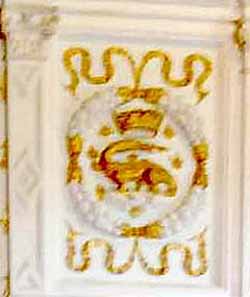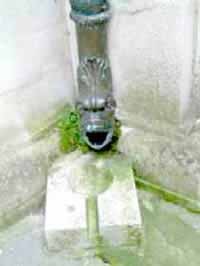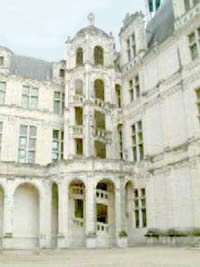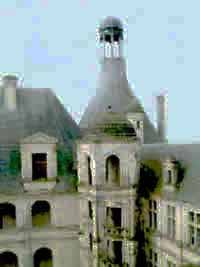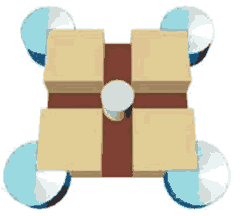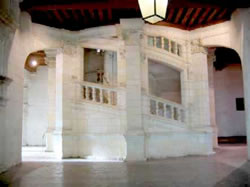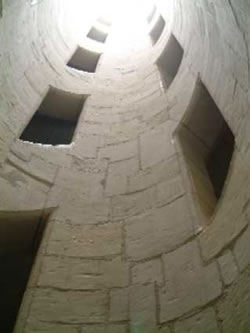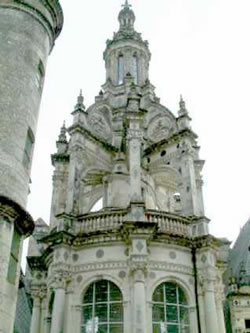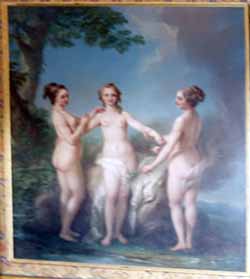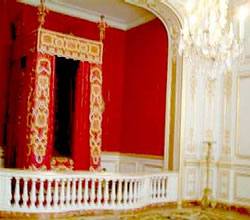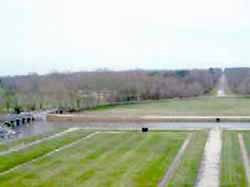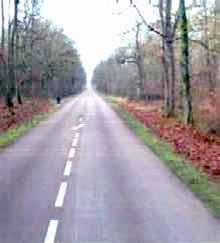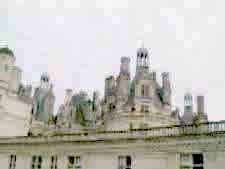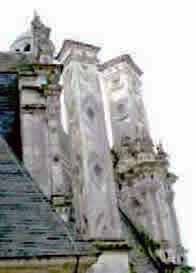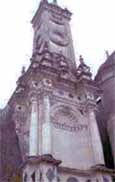
| Château quiz |
| Worksheet 1. |
| Worksheet 2. |
|
Find out about one of the most visited châteaux , Chambord.
|
Le château de Chambord is probably the most recognisable and best known of all the châteaux in France. Many people think that it is also one of the most beautiful in terms of its design. Find out a little about its history and what you might see if you visited this château. François had been involved with the French wars in Italy and had been very impressed with the architecture he had seen there. He was also very interested in the arts and sciences. He succeeded persuading Leonardo da Vinci to come to France with the aim of using his knowledge and skills to create a château in the new Renaissance style. In Chambord, Leonardo and François managed to blend the elements of the new Italian Renaissance architecture with those of French tradition. Click here to see the construction plan of Chambord based on masons' traditional measurements and Leonardo's concepts of perfection and beauty. Chambord was not totally new as it was built on the site of an old castle that had been used by the royals in the past for hunting. Surrounded by thick forests, which were full of game, situated close to the Loire river and in a location of natural beauty, the site was ideal for François' dream château. Work started on the château in 1519, with 2000 workmen on site. It took until 1547 to complete the building. It is probably the most recognisable of all the chateaux because of its distinct shape. It has 440 rooms, 365 chimneys (one for each day of the year - but really to enable each room to be independently heated), 80 staircases and 800 sculptured columns. This château left the other kings of Europe gasping in admiration at the time, but François actually spent very little time in his masterpiece. This is a stylised plan of the château showing the geometric patterns and symmetry of its layout. The layout of the main part of the château shows how the cross shaped corridor, coloured dark brown, connects the rooms (light brown). These corridors are intersected at their centre by a double circular central staircase. This unique staircase was a project of Leonardo da Vinci's, it is a double helix, with neither staircase ever meeting the other. It connects the three main levels of the building. On the right are some pictures of this staircase. It was said that it was designed so that those who went up could not see those who were descending, and vice versa. Inside the staircases looking up, the windows provide only swift glimpses of the staircase users. The top of the double helix staircase ends at the terrace on the roof of the building and the central bell tower. The tower is covered in decorative sculptures. François' personal emblem was the salamander, and this can be found carved into walls, ceilings and doors throughout the palace.
François was a man who loved the ladies. He included 27 young ladies of rank in his own household and even more in that of the Queen. He said:"a court without women is like a year without a spring and a spring without roses." One of his favourite mistresses was Diane de Poitiers.
The "Three Graces" (pictured below) were three sisters who also became François' mistresses. At some stage, though, the King must have been badly let down by one of his ladies. Taking his diamond ring, he wrote on a window pane, in his workroom, in 1545: Souvent femme varie, bien fol est qui s'y fie. The King's bedroom was placed near those of the Queen's and his mistress. Even in a hunting castle such as this, the King's bedroom was not a private place; there were intricate ceremonies for going to bed and getting up, undressing and dressing which involved the courtiers of the highest rank. The King also had a long room which he used as an audience hall and a workroom, reached by its own staircase. Chambord was so admired when it was built because of its decorative beauty. It is important to remember that the skill of building domes was rediscovered during the Renaissance. Leonardo's design exploited the use of domes. However, he also chose to make the important necessities such as the humble chimney pots, guttering and down pipes into pieces of artwork. Below are some pictures which illustrate the intricate decoration of the outside of the château.
Close to the château, the land was drained and streams diverted to create canals and lakes. These supplied water and fish as well as being for recreational use. The forest was turned into usable parkland close to the château. The grass was grazed by sheep in order to keep it short (lawn mowers were not invented so sheep were used instead). Wide stretches of land were cleared through the forest which served both as a fire break and as "rides" through which people and horses could move quickly without having to avoid trees and undergrowth. When Chambord was first built, it was surrounded by hunting forest in every direction, as far as the eye could see. King François used to hunt deer here, and there were wild boar, too. As well, there were all the traditional smaller game animals and birds. Only the King and his invited guests were allowed to hunt in the forest. There were dreadful penalties for those who were caught poaching the game. Today, the park surrounding Chambord is still very large. At 5400 hectares it is the biggest forest park in Europe. It is surrounded by a wall 32 km in length. There are six gateways to gain entrance. In the park, there are 23 farms, rivers, marshes, forests and heath land. |
The king most associated with Chambord is King François 1er, who came to the throne when he was only 20 years old.
King François 1er.
Le château de Chambord - The wonderful château of François 1er.
The basic plan of ChambordSource: service éducatif du domain nationale de Chambord.
Leonardo da Vinci's famous staircase photographed on the first level. The staircase intricacies provide an interesting puzzle as to which one to take.
Ground level. It is not possible to photograph both staircases at the same time
Inside the stairwell, you can see both staircases.
The stair tower at roof level.
The front door at Chenonceau has François 1er's symbol of the salamander on it
The King's bedroom
The Park, seen from the château.
It is a long drive through the forest land to reach the château.
Intricate detail of towers on the roof line.
Coloured stones, carvings and sculptures decorate the chimney pots. |
|
Part of an exterior wall at Chambord showing use of coloured stone, carving and sculptures.
|
Penrose
